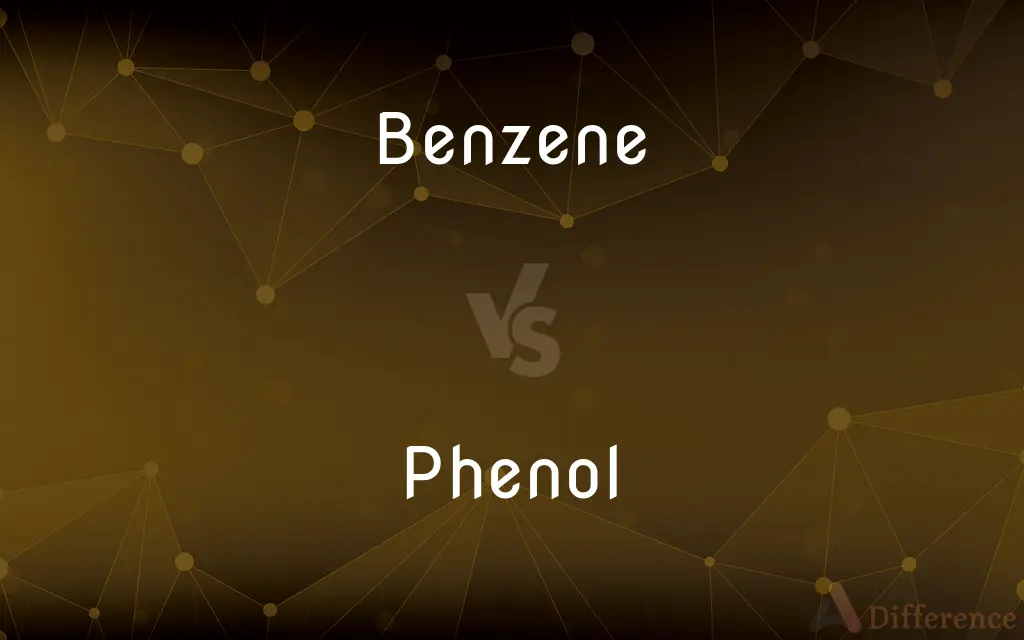Benzene vs. Phenol — What's the Difference?
Edited by Tayyaba Rehman — By Maham Liaqat — Updated on March 14, 2024
Benzene is an aromatic hydrocarbon with a formula C6H6, known for its simple ring structure. Phenol, also aromatic, is C6H5OH, featuring a benzene ring bonded to a hydroxyl group, giving it distinct properties and uses.

Difference Between Benzene and Phenol
Table of Contents
ADVERTISEMENT
Key Differences
Benzene is a fundamental organic chemical, a colorless and highly flammable liquid with a sweet smell, used primarily as a precursor to the production of other chemicals, such as plastics, resins, and synthetic fibers. Phenol, on the other hand, is a derivative of benzene where one hydrogen atom in the benzene ring is replaced by a hydroxyl group (-OH), which significantly alters its chemical behavior.
The introduction of the hydroxyl group in phenol not only affects its physical properties, such as melting and boiling points, but also its solubility. Phenol is more soluble in water than benzene due to the polar nature of the hydroxyl group, which can form hydrogen bonds with water molecules. This difference in solubility reflects their diverse uses and handling in industrial and laboratory settings.
Safety and environmental concerns are significant for both chemicals, but benzene is particularly noted for its carcinogenic properties, leading to strict regulations on its exposure. Phenol, while toxic, is managed for its corrosive properties and potential health effects. Both substances require careful handling, with specific guidelines to mitigate risks to health and the environment.
In terms of applications, benzene's role as a building block for other chemicals makes it indispensable in the chemical industry. Phenol's reactivity and acidity lend it to uses that range from the production of resins and plastics to pharmaceuticals, illustrating how a single functional group modification can broaden the scope of applications.
Comparison Chart
Formula
C6H6
C6H5OH
ADVERTISEMENT
Structure
Hexagonal carbon ring
Benzene ring with a hydroxyl group
Physical State
Colorless, flammable liquid
White crystalline solid
Uses
Precursor in chemicals, plastics
Plastics, explosives, antiseptics
Solubility
Low in water
Higher in water due to -OH group
Reactivity
Less reactive
More reactive due to -OH group
Health Concerns
Carcinogenic
Toxic, corrosive
Compare with Definitions
Benzene
Aromatic hydrocarbon.
Benzene is used in the synthesis of nylon.
Phenol
Benzene derivative.
Phenol's hydroxyl group makes it distinct from benzene.
Benzene
Chemical precursor.
Benzene is foundational in making various dyes.
Phenol
Used in resins.
Phenol is a key ingredient in Bakelite production.
Benzene
Carcinogenic risk.
Long-term benzene exposure is linked to leukemia.
Phenol
More soluble in water.
Phenol's solubility is due to its hydroxyl group.
Benzene
Colorless liquid.
Benzene has a distinctive sweet odor.
Phenol
Medical antiseptic.
Phenol was historically used for its antiseptic properties.
Benzene
Stabilized by delocalized electrons.
Benzene's stability is due to its aromaticity.
Phenol
Weak acid.
Phenol can lose a hydrogen ion from its hydroxyl group.
Benzene
Benzene is an organic chemical compound with the molecular formula C6H6. The benzene molecule is composed of six carbon atoms joined in a planar ring with one hydrogen atom attached to each.
Phenol
Phenol (also called carbolic acid) is an aromatic organic compound with the molecular formula C6H5OH. It is a white crystalline solid that is volatile. The molecule consists of a phenyl group (−C6H5) bonded to a hydroxy group (−OH).
Benzene
A colorless, flammable, toxic, liquid aromatic hydrocarbon, C6H6, derived from petroleum and used in or to manufacture a wide variety of chemical products, including DDT, detergents, insecticides, and motor fuels. Also called benzol.
Phenol
A mildly acidic toxic white crystalline solid obtained from coal tar and used in chemical manufacture, and in dilute form (under the name carbolic) as a disinfectant.
Benzene
(organic compound) An aromatic hydrocarbon of formula C6H6 whose structure consists of a ring of alternate single and double bonds.
Phenol
A caustic, poisonous, white crystalline compound, C6H6O, derived from benzene and used in resins, plastics, and pharmaceuticals and in dilute form as a disinfectant. Also called carbolic acid.
Benzene
Sometimes used in place of the phenyl group.
Phenol
Any of a class of aromatic organic compounds having at least one hydroxyl group attached directly to the benzene ring.
Benzene
A volatile, very inflammable liquid, C6H6, contained in the naphtha produced by the destructive distillation of coal, from which it is separated by fractional distillation. The name is sometimes applied also to the impure commercial product or benzole, and also, but rarely, to a similar mixed product of petroleum.
Phenol
A caustic, poisonous, white crystalline compound, C6H5OH, derived from benzene and used in resins, plastics, and pharmaceuticals and in dilute form as a disinfectant and antiseptic; once called carbolic acid
Benzene
A colorless liquid hydrocarbon; highly inflammable; carcinogenic; the simplest of the aromatic compounds
Phenol
Any of a class of aromatic organic compounds having at least one hydroxyl group attached directly to the benzene ring (or other aromatic ring)
Phenol
A white or pinkish crystalline substance, C6H5OH, produced by the destructive distillation of many organic bodies, as wood, coal, etc., and obtained from the heavy oil from coal tar.
Phenol
Any one of the series of hydroxyl derivatives of which phenol proper is the type.
Phenol
Any of a class of weakly acidic organic compounds; molecule contains one or more hydroxyl groups
Phenol
A toxic white soluble crystalline acidic derivative of benzene; used in manufacturing and as a disinfectant and antiseptic; poisonous if taken internally
Common Curiosities
Is phenol more reactive than benzene?
Yes, the presence of the hydroxyl group makes phenol more reactive than benzene.
Can phenol dissolve in water?
Phenol is more soluble in water than benzene due to its hydroxyl group, which can form hydrogen bonds with water.
What are the safety concerns with handling phenol?
Phenol is toxic and corrosive, requiring precautions to prevent skin contact and inhalation.
Why is benzene carcinogenic?
Benzene exposure can cause changes to the DNA within cells, leading to cancers such as leukemia.
What is benzene used for?
Benzene is primarily used as an intermediate to make other chemicals, including plastics, resins, and synthetic fibers.
How does phenol differ from benzene?
Phenol contains a hydroxyl group attached to the benzene ring, altering its chemical properties and uses significantly.
How are benzene and phenol regulated?
Due to their health and environmental impacts, both chemicals are subject to strict regulations regarding their use, handling, and disposal.
How is benzene produced?
Benzene is produced from both natural processes, such as volcanoes and forest fires, and industrial processes, including oil refining and chemical synthesis.
Are there environmental concerns with benzene and phenol?
Both chemicals pose environmental risks, including pollution and toxicity to aquatic life, necessitating careful waste management.
What makes phenol a weak acid?
Phenol's acidic nature comes from its ability to donate a hydrogen ion (proton) from its hydroxyl group to a water molecule.
Share Your Discovery

Previous Comparison
Thyroid vs. Thymus
Next Comparison
Thailand vs. TaiwanAuthor Spotlight
Written by
Maham LiaqatEdited by
Tayyaba RehmanTayyaba Rehman is a distinguished writer, currently serving as a primary contributor to askdifference.com. As a researcher in semantics and etymology, Tayyaba's passion for the complexity of languages and their distinctions has found a perfect home on the platform. Tayyaba delves into the intricacies of language, distinguishing between commonly confused words and phrases, thereby providing clarity for readers worldwide.














































